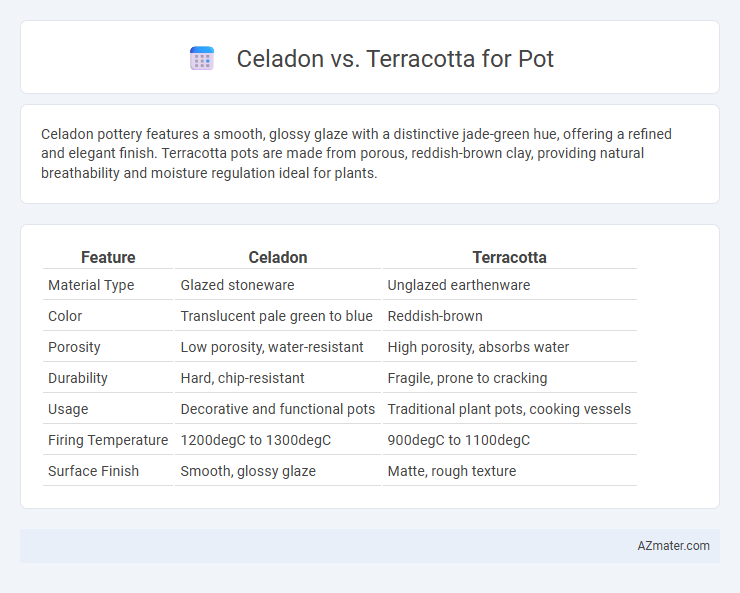Celadon pottery features a smooth, glossy glaze with a distinctive jade-green hue, offering a refined and elegant finish. Terracotta pots are made from porous, reddish-brown clay, providing natural breathability and moisture regulation ideal for plants.
Table of Comparison
| Feature | Celadon | Terracotta |
|---|---|---|
| Material Type | Glazed stoneware | Unglazed earthenware |
| Color | Translucent pale green to blue | Reddish-brown |
| Porosity | Low porosity, water-resistant | High porosity, absorbs water |
| Durability | Hard, chip-resistant | Fragile, prone to cracking |
| Usage | Decorative and functional pots | Traditional plant pots, cooking vessels |
| Firing Temperature | 1200degC to 1300degC | 900degC to 1100degC |
| Surface Finish | Smooth, glossy glaze | Matte, rough texture |
Introduction to Celadon and Terracotta Pots
Celadon pots are distinguished by their smooth, jade-like glaze that offers a translucent, pale green to blue finish, originating from ancient East Asian pottery traditions. Terracotta pots, crafted from natural clay, display a porous, reddish-brown surface that enhances breathability and moisture regulation for plants. Both materials present unique aesthetic and functional qualities, with celadon emphasizing elegance and terracotta favoring rustic durability.
Historical Origins of Celadon and Terracotta
Celadon pottery originated in ancient China during the Eastern Han Dynasty (25-220 AD), renowned for its jade-like green glaze achieved through a precise iron oxide reduction firing process. Terracotta dates back to prehistoric times, with evidence of its use by ancient civilizations such as Mesopotamians and Indus Valley people, characterized by its porous, reddish-brown baked clay composition. These distinct historical origins highlight Celadon's association with refined, glazed ceramics and Terracotta's widespread utilitarian role in pottery and sculpture.
Material Composition and Manufacturing Process
Celadon pots are traditionally crafted from a refined stoneware clay known for its high iron content, which interacts with the kiln's oxygen-reducing atmosphere to produce their signature translucent green glaze. Terracotta pots are made from earthenware clay rich in iron oxide and other minerals, which is fired at lower temperatures, resulting in their characteristic porous, reddish-brown finish. The celadon manufacturing process involves precise temperature control and glazing techniques to achieve a glass-like surface, whereas terracotta pots undergo a simpler, often unglazed firing that preserves their natural texture and breathability.
Aesthetic Differences: Color, Texture, and Finish
Celadon pots feature a smooth, translucent glaze with a soft green to bluish hue, creating an elegant and serene aesthetic. Terracotta pots reveal a warm, earthy reddish-brown color with a slightly rough texture that emphasizes their natural, rustic appeal. The glossy finish of celadon contrasts with the matte, porous surface of terracotta, highlighting their distinct visual and tactile qualities.
Durability and Longevity Comparison
Celadon pots, known for their glassy, translucent glaze, offer moderate durability but can be prone to chipping due to their delicate surface finish. Terracotta pots exhibit superior longevity and durability as they are made from unglazed, porous clay that withstands weathering and physical impact better over time. In outdoor or high-use environments, terracotta remains a more practical choice for long-term planting solutions due to its robust nature and natural breathability.
Suitability for Indoor and Outdoor Use
Celadon pottery, with its smooth glaze and delicate finish, excels in indoor settings where moisture and temperature fluctuations are minimal, preserving its refined appearance over time. Terracotta pots are highly durable and porous, making them ideal for outdoor use as they allow air and moisture to circulate, promoting healthy root systems while withstanding weather elements. Both materials offer distinct benefits: celadon is favored for indoor decorative plants requiring controlled environments, whereas terracotta suits outdoor gardening due to its breathability and toughness.
Impact on Plant Health and Growth
Celadon pots, made from glazed ceramic, provide a non-porous surface that retains moisture longer, supporting consistent hydration for plants and reducing the risk of root rot. Terracotta pots, made from porous clay, allow air and moisture to pass through their walls, promoting better aeration and preventing waterlogging, which benefits root respiration and overall plant health. Choosing between celadon and terracotta depends on the specific water and aeration needs of the plant species to optimize growth and vitality.
Price Range and Availability
Celadon pots typically range from $30 to $150 depending on craftsmanship and origin, with availability concentrated in specialty artisan shops and online marketplaces. Terracotta pots are generally more affordable, priced between $10 and $50, and widely available at garden centers, home improvement stores, and mass retailers. Both materials offer diverse styles, but terracotta is easier to find and budget-friendly compared to the more exclusive and higher-priced celadon options.
Environmental Considerations
Celadon pots, made through high-temperature glazing techniques, offer enhanced durability and reduced porosity, which helps minimize water usage and prevents soil contamination, promoting sustainable gardening practices. Terracotta pots, crafted from natural clay fired at lower temperatures, are biodegradable and allow for better air and moisture exchange, supporting healthy root systems while decomposing naturally without leaving harmful residues. Choosing between celadon and terracotta involves balancing the energy footprint of production with the ecological benefits of material composition and lifecycle impact on plant health and soil quality.
Choosing the Right Pot: Celadon vs Terracotta
Choosing between celadon and terracotta pots depends on the desired aesthetic and plant care needs; celadon pots, with their glossy, glazed surface, provide a more decorative, moisture-retentive environment ideal for delicate or moisture-loving plants. Terracotta pots offer excellent breathability due to their porous nature, promoting healthy root aeration and preventing overwatering for drought-tolerant species. Consider the pot's environment, plant type, and watering habits when selecting between celadon's elegant finish and terracotta's natural, breathable qualities.

Infographic: Celadon vs Terracotta for Pot
 azmater.com
azmater.com